By Dave Hemenway
One of the goals of the Cape Dory Sailboat Owners Association (CDSOA) and the new Typhoon Class Association (TCA) is a program we are calling SOS – Save Our Sailboats. Our goal is to rescue as many neglected, often abandoned, boats and find new owners who are willing to restore them into the fine vessels they were and can be again. In the first six months of the program, we saved seven Typhoons and helped a Cape Dory 25D owner rehome his cherished vessel. One of the Typhoons has been completely restored and I am working on two more that will be ready for this year’s sailing season. I’ve been very busy working on these boats and my shop is pretty much at capacity.
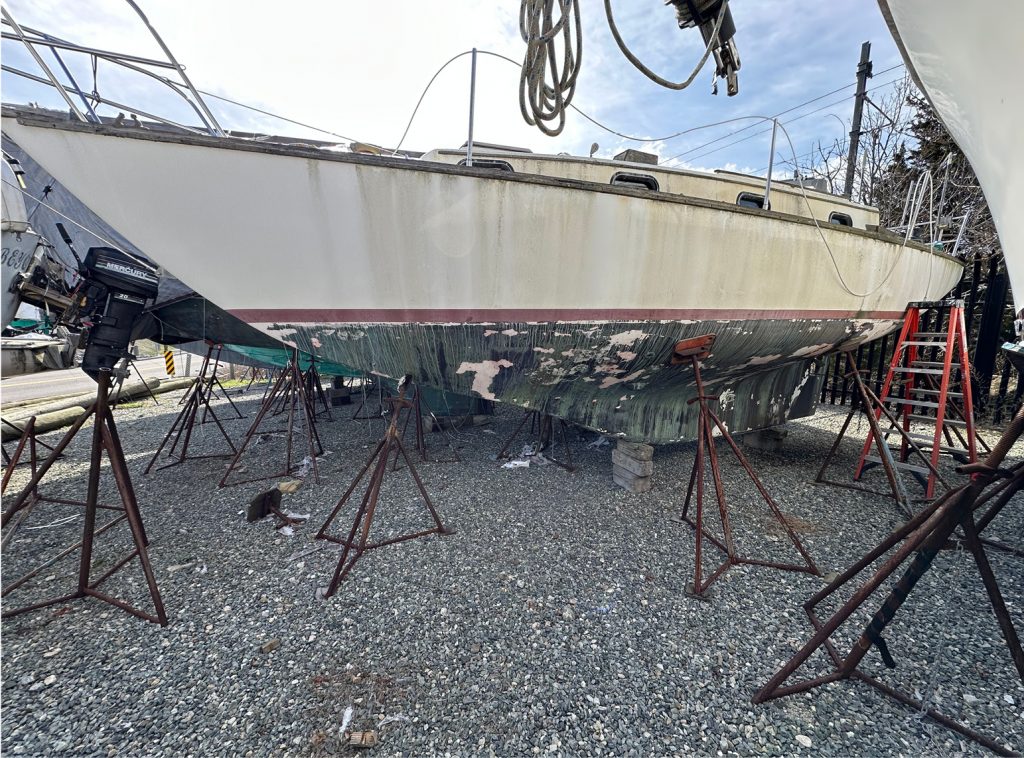
Moonshadow as found
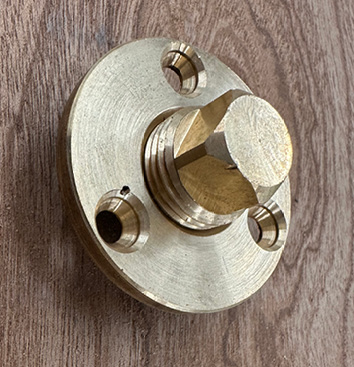
Installing a drain plug (and leaving it open for long-term storage on the hard) might have prevented costly water damage on many neglected boats.
Many of us enjoy our hobby of working on old boats almost as much as sailing them. Typhoons are great first project boats for someone who would like to resurrect an unloved boat because they’re about as simple as a keel sailboat can be. They are also easily moved on a trailer so they can be worked on at home and there are many available. There is a wealth of restoration information in the Forum section of the CDSOA website (capedorysoa.org) which has been collecting Cape Dory information for over forty years.
There is an old expression “There is nothing more expensive than a free boat.” While it is true that free boats are not free because of the work they require, it is also true that restoring a forlorn boat allows an owner to fully understand their boat, be sure she’s in seaworthy condition, be able to modify her to meet their personal needs, and equip her as they see fit. This is often accomplished for significantly less money than buying a boat that is supposedly in good condition, but often needs significant work once the new owner gains familiarity with their newly acquired vessel. In addition, you are keeping another boat out of our landfills.
In my experience, it is often less expensive to pay a premium price for a boat that’s actually in excellent condition than to pay less for a boat that is much cheaper, but in mediocre condition. Most boats that are thirty or more years old have problems that need to be addressed, and if they haven’t had this necessary maintenance significant collateral damage may have occurred.
The classic example of this is failed bedding compound on deck fittings that has allowed water to seep into the cored deck which caused it to deteriorate. While fixing a rotten cored deck is a significant repair, it is often doable for most people who are at all handy with tools. It’s a nasty project, but usually not a hard one. Another common example is water damage to the interior of a boat that does not have a proper drain plug. This can cause significant damage, which is such a shame because installing a drain plug is a trivial project that could save many boats. In my opinion, all boats should have a simple drain plug to prevent serious damage when rainwater gets into the hull which often happens to boats that are dry stored on land for years. This problem is easily solved with a drain plug.
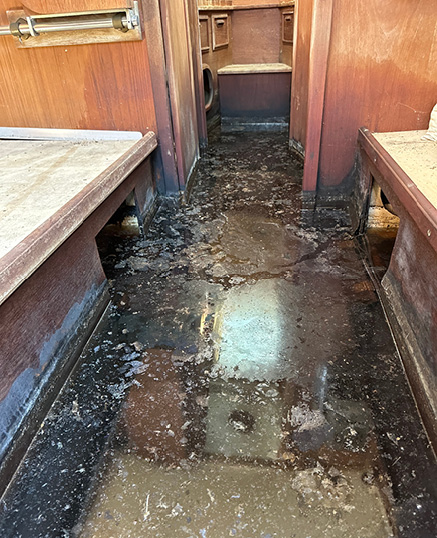
This is what happens when water cannot escape a boat in storage.
One of my pastimes is surfing the web before going to sleep. It is fun seeing what’s going on in the Cape Dory world. In mid-April, I noticed a post on one of the Cape Dory Facebook pages about a 1982 Cape Dory 30 Cutter # 237 named Moonshadow that needed a new owner. This post was originally posted in Fall 2022 by a daughter of the family who owned her and had just surfaced again when someone asked if anyone knew about this boat as it has been in land storage at a local marina for many years. I remembered seeing this forlorn Cape Dory when I stored one of my boats at that marina many years ago. Even then, Moonshadow showed her proud Cape Dory heritage despite her degrading condition. I felt sorry for her while I admired her excellent design.
On a whim, I responded to the post and asked about this proud old, neglected boat. The author of the original post responded within fifteen minutes and we exchanged contact information. I asked if I could take a look at the boat the following day. She said she thought that would be fine, but needed to ask her mother who owned the boat. The mother contacted me the following morning and said she’d be very happy if I would check out Moonshadow as no one had checked on her for a couple of years.
My first impression of Moonshadow was she doesn’t look too bad for a boat that has been on the hard for so many years. I walked around her and noticed her bottom is in very good condition. The rudder is frozen in place from so many years of sitting. I went up on the deck and walked around the decks which were strong and in decent shape with the normal spider cracks, but didn’t notice any soft areas until I stepped into the cockpit which was soft with a clear case of a rotten balsa core. This finding was not too concerning as I have fixed several decks with this ailment. My second impression was heartbreaking as I opened the main hatch and stared into a cabin sole with an oily mess of water about six inches deep. I was saddened to see this mess which could easily have been avoided with a simple drain plug.
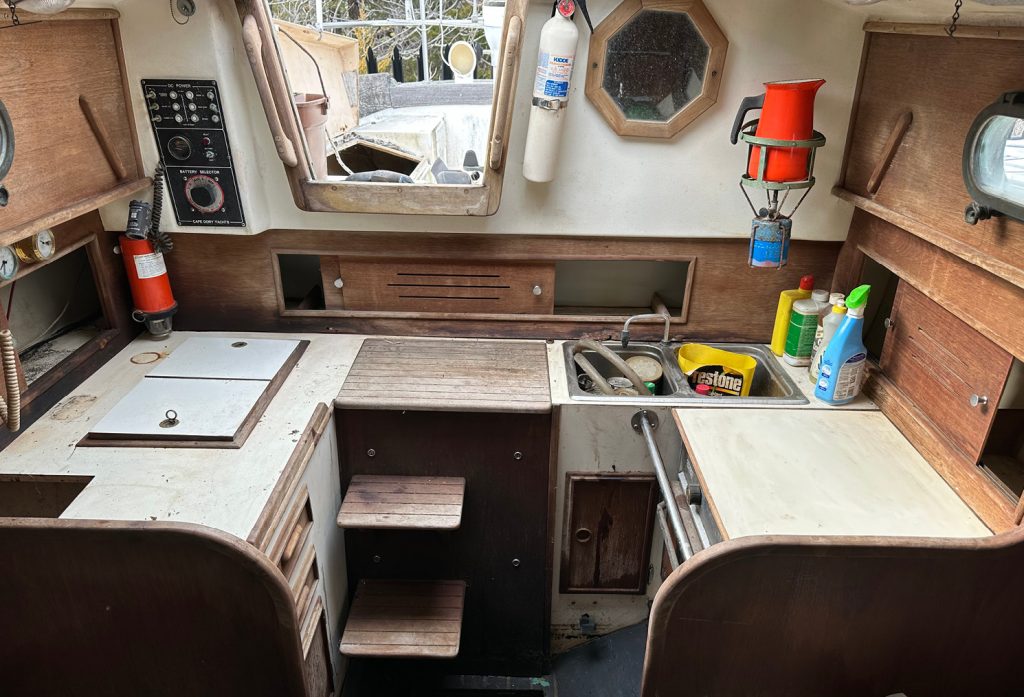
The galley’s actually in decent shape.
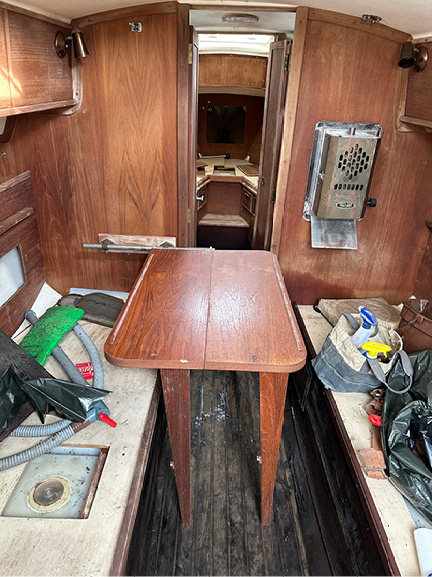
The author’s grandchildren will enjoy exploring Moonshadow’s salon and forepeak during future cruises.
Since I brought my muck boots and a manual bilge pump to deal with this possibility, I was able to bail her out in a couple hours and determine her basic condition. Fortunately, the owner had removed all her sails, cushions, and miscellaneous equipment when she was put in storage. But she was a wet mess crying out to be saved because her basic structure was strong. While her bulkheads are still structurally sound, several pieces of her plywood interior will have to be replaced which is no big deal for me.
I closed her up and returned to the owner’s home to discuss the situation. She and her husband have owned Moonshadow since the late 1980s and sailed her all over the East Coast as he was a Coast Guard officer who was routinely transferred. They raised their family on Moonshadow and made countless memories. But time passed and health challenges occurred which precluded their use of their well-loved boat. No one had taken their offer for a free boat seriously for more than two years and something had to be done or she would be scrapped, which the family did not want to happen. I told the owner that I would seriously think about Moonshadow, discuss it with my family, and let her know my decision in the morning.

Moonshadow’s bad plywood will be replaced.
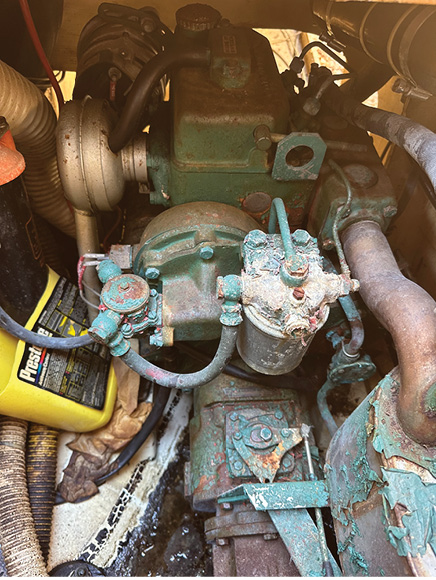
Getting the Volvo diesel to run should be among the easier parts of this restoration.
I spent the evening thinking about this new project and wondered what I should do. While I didn’t need any more projects and am thrilled with my Typhoons which allow me to experience the pure joy of simple sailing, I did like the idea of having another boat which is very similar to my Alberg 30 that I sailed offshore from Miami to Baltimore in one trip with a crew and another from Baltimore to Florida and back, sailing singlehanded in the Intracoastal Waterway. Moonshadow is very similar to the Alberg 30 since they were both designed by the legendary Carl Alberg. I liked the easily managed cutter sail plan, the simple 14 hp Volvo diesel which can be hand started, the ability to sail under an awning with all sails flying, and the comfortable accommodations that a thirty-foot boat allows. I could easily cruise with my family or a friend or two instead of singlehanding as I normally do on my 24-foot boat. Having a reliable diesel would be a significant upgrade from an outboard powered sailboat. My wife liked the idea of these improvements, but was concerned that I was overextending myself in taking on another project.
I decided to accept Moonshadow with the understanding that all yard bills were paid and I would have six weeks to make her seaworthy enough to tow her with my skiff from Noank to the Thames River where I have a spare mooring. The owner and her family are ecstatic and I’m pleased to have a new project boat that will soon be returned to service instead of being cut up and put into a landfill. I’m thrilled that I will have a nice, simple, appropriately sized boat for my future cruises in safety and comfort as an older sailor.
My projects to make her seaworthy for the move to her new mooring are to free/service all the frozen seacocks, remove the old toilet and holding tank, make the rudder operational, paint the bottom, and replace the cockpit floor. I will work on the engine, which turns over and has no water in the oil, and rig her with the Boating on the Thames crew and their crane. Moonshadow is scheduled to go back in the water the first week of June and she will join her little Typhoon sisters in the Thamses River near New London, Connecticut. I look forward to sharing her restoration with my fellow WindCheck readers. ■
Dave Hemenway, Northeast fleet captain of the Cape Dory Sailboat Owners Association, lives in Eastern Connecticut and sails out of Boating on the Thames in New London. He’s been sailing and messing about in boats for his whole life and has recreationally sailed Finns on and off since the 1970s. His primary cruising boat is a Dickerson 36 yawl that he’s maintained and improved for 35 years. Since retiring from higher education, he has worked at Cappy’s Boat Shop where he reports to his dog, Cappy.



